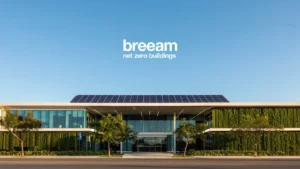In an era where climate change and sustainability are at the forefront of global discourse, the construction industry stands as a pivotal player in shaping a more environmentally responsible future. In the United Kingdom, where the built environment accounts for a significant portion of carbon emissions and resource consumption, the need for sustainable building practices has never been more pressing. This is where the Building Research Establishment Environmental Assessment Method (BREEAM) comes into play, offering a robust framework for evaluating and enhancing the sustainability performance of buildings. At the heart of BREEAM lies Lifecycle Analysis, a sophisticated tool that enables organizations to assess the environmental impacts of buildings throughout their entire lifecycle.
The significance of BREEAM Lifecycle Analysis extends far beyond compliance; it represents a fundamental shift towards more holistic and forward-thinking approaches to building design, construction, and operation. By systematically evaluating the environmental impacts associated with different stages of a building’s lifecycle, organizations can identify opportunities for improvement, optimize resource use, and minimize negative environmental consequences. In this comprehensive guide, we delve into the intricacies of BREEAM Lifecycle Analysis, exploring its importance, benefits, process, tools, challenges, and future trends, with the aim of empowering UK-based businesses to embrace sustainability and drive positive change in the built environment.
Understanding BREEAM Lifecycle Analysis
Definition and Importance
BREEAM Lifecycle Analysis, also known as Life Cycle Assessment (LCA), is a methodology used to quantify and evaluate the environmental impacts associated with the entire lifecycle of a building, from cradle to grave. Unlike traditional approaches that focus solely on operational energy consumption or carbon emissions, Lifecycle Analysis considers a broader range of environmental factors, including resource depletion, water use, waste generation, and ecosystem impacts. This holistic perspective is critical for identifying hidden environmental hotspots, assessing trade-offs between different sustainability objectives, and informing strategic decision-making throughout the building lifecycle.
Key Components of Lifecycle Analysis
Lifecycle Analysis within the BREEAM framework typically comprises four key components:
- Goal and Scope Definition: This initial stage involves defining the objectives of the analysis and establishing the boundaries of the study, including the functional unit, system boundaries, and life cycle stages to be included.
- Inventory Analysis: During this stage, data is collected on the inputs (e.g., materials, energy) and outputs (e.g., emissions, waste) associated with each stage of the building’s lifecycle.
- Impact Assessment: Impact categories, such as greenhouse gas emissions, energy consumption, water use, and waste generation, are quantified and evaluated to assess the environmental impacts of the building.
- Interpretation and Reporting: The final stage involves interpreting the results of the analysis, identifying opportunities for improvement, and communicating findings to stakeholders through comprehensive reports and presentations.
Integration within BREEAM Assessment
Lifecycle Analysis is integrated within the broader BREEAM assessment process, where it contributes to the Environmental section of the BREEAM rating system. By conducting Lifecycle Analysis, projects can earn credits towards achieving higher BREEAM ratings, demonstrating their commitment to sustainable development and environmental stewardship. Additionally, Lifecycle Analysis serves as a valuable tool for benchmarking environmental performance, identifying areas for improvement, and informing design decisions throughout the project lifecycle.
Benefits of Conducting BREEAM Lifecycle Analysis
Environmental Benefits
Conducting BREEAM Lifecycle Analysis offers numerous environmental benefits. By systematically evaluating the environmental impacts of building materials, processes, and systems, organizations can identify opportunities to reduce resource consumption, minimize emissions, and mitigate environmental degradation throughout the building lifecycle. For example, Lifecycle Analysis may reveal that replacing traditional building materials with more sustainable alternatives, such as recycled or low-carbon materials, can significantly reduce the carbon footprint of a building and minimize ecological damage associated with resource extraction and manufacturing.
Economic Benefits
In addition to environmental advantages, BREEAM Lifecycle Analysis can yield significant economic benefits for businesses. By optimizing resource use, minimizing waste generation, and enhancing energy efficiency throughout the building lifecycle, organizations can achieve cost savings through reduced operational expenses, lower utility bills, and enhanced asset value. Furthermore, Lifecycle Analysis enables businesses to identify cost-effective opportunities for improving sustainability performance and maximizing return on investment in green building initiatives.
Social Benefits
Beyond environmental and economic considerations, conducting BREEAM Lifecycle Analysis can generate social benefits for communities and occupants. By prioritizing sustainable building practices and materials, organizations can create healthier, more comfortable, and more resilient built environments that promote occupant well-being and satisfaction. For example, designing buildings with improved indoor air quality, natural lighting, and thermal comfort not only enhances occupant health and productivity but also fosters a sense of community and belonging among building occupants.
Process of Conducting BREEAM Lifecycle Analysis
Data Collection and Inventory Analysis
The first step in conducting BREEAM Lifecycle Analysis involves collecting data on the inputs and outputs associated with each stage of the building’s lifecycle. This includes gathering information on the materials used in construction, energy consumption during operation, maintenance practices, and end-of-life disposal methods. Data sources may include product specifications, energy bills, maintenance records, and waste management reports. Once data is collected, it is organized and analyzed to quantify the environmental impacts of the building across its lifecycle.
Impact Assessment
Once the inventory of inputs and outputs is compiled, impact assessment methodologies are applied to quantify and evaluate the environmental impacts associated with the building’s lifecycle. This typically involves assessing impacts across multiple environmental categories, such as climate change, resource depletion, human health, and ecosystem quality. Impact assessment methodologies may vary depending on the goals and scope of the analysis, but commonly used approaches include life cycle impact assessment (LCIA) methods such as Eco-Indicator 99, ReCiPe, and CML.
Interpretation and Reporting
The final stage of BREEAM Lifecycle Analysis involves interpreting the results of the impact assessment and reporting findings to stakeholders. This may include identifying environmental hotspots, prioritizing mitigation strategies, and communicating recommendations for improving sustainability performance. Comprehensive reports and presentations are typically prepared to convey the results of the analysis in a clear and understandable format, facilitating informed decision-making and stakeholder engagement.
Tools and Resources for BREEAM Lifecycle Analysis
BREEAM Methodology and Guidance
The BREEAM framework provides comprehensive guidance and methodologies for conducting Lifecycle Analysis within the assessment process. BREEAM assessment criteria and technical manuals offer detailed instructions and requirements for performing Lifecycle Analysis, including data collection, impact assessment, and reporting. Additionally, BREEAM provides access to accredited assessors and training programs to support organizations in conducting Lifecycle Analysis and achieving sustainability goals.
Software and Calculation Tools
A variety of software tools and calculation methodologies are available to facilitate BREEAM Lifecycle Analysis. Life cycle assessment (LCA) software packages, such as SimaPro, GaBi, and OpenLCA, offer advanced modeling capabilities and databases of environmental impacts associated with building materials and processes. Additionally, BREEAM-specific calculation tools and spreadsheets are available to streamline the data collection, analysis, and reporting processes, making it easier for organizations to conduct Lifecycle Analysis and achieve BREEAM certification.
Challenges and Solutions
Common Challenges in Conducting Lifecycle Analysis
While BREEAM Lifecycle Analysis offers numerous benefits, organizations may encounter several challenges during the process. Common challenges include data availability and quality, modeling uncertainties, stakeholder engagement, and resource constraints. Additionally, navigating the complexities of impact assessment methodologies and interpretation of results can pose challenges for organizations with limited expertise or experience in sustainability assessment.
Strategies to Overcome Challenges
To overcome these challenges and successfully conduct BREEAM Lifecycle Analysis, organizations can adopt several strategies and best practices. This may include investing in data collection and management systems to improve data availability and quality, engaging stakeholders early and often throughout the analysis process to ensure alignment of goals and expectations, and collaborating with experienced consultants or assessors to address technical challenges and uncertainties. Additionally, organizations can leverage resources such as BREEAM training programs, guidance documents, and online forums to enhance their knowledge and expertise in Lifecycle Analysis and sustainability assessment.
Future Trends in BREEAM Lifecycle Analysis
Emerging Technologies and Methodologies
As sustainability continues to evolve, BREEAM Lifecycle Analysis is expected to incorporate emerging technologies and methodologies to improve accuracy, efficiency, and transparency. Advances in data analytics, artificial intelligence, and remote sensing technologies offer new opportunities for collecting and analyzing lifecycle data, while advancements in life cycle impact assessment (LCIA) methodologies and databases enable more comprehensive and robust environmental assessments. Additionally, the integration of Building Information Modeling (BIM) and digital twin technologies with Lifecycle Analysis holds promise for enhancing sustainability performance throughout the building lifecycle.
Anticipated Changes in BREEAM Criteria
In response to emerging trends and stakeholder feedback, BREEAM criteria related to Lifecycle Analysis are expected to evolve over time. Anticipated changes may include updates to assessment methodologies, expansion of impact categories, and incorporation of new performance metrics to address emerging sustainability challenges and priorities. Additionally, BREEAM may place greater emphasis on transparency, stakeholder engagement, and verification of lifecycle data to ensure the credibility and integrity of assessment results.
As we navigate the complexities of the 21st century, sustainability has emerged as a defining imperative for businesses seeking to thrive in a rapidly changing world. BREEAM Lifecycle Analysis represents a critical tool in this endeavor, offering a systematic approach to evaluating and enhancing the sustainability performance of buildings. By embracing Lifecycle Analysis, UK-based businesses can unlock a myriad of benefits, ranging from environmental stewardship and economic savings to social well-being and resilience. As we look to the future, BREEAM Lifecycle Analysis will continue to play a vital role in shaping a more sustainable and prosperous built environment for generations to come.
Are you ready to embark on a journey towards sustainability excellence?
Take the first step by exploring BREEAM Lifecycle Analysis and its transformative potential for your organization. Contact our team of sustainability experts today to learn more about how BREEAM Lifecycle Analysis can help you achieve your sustainability goals, drive innovation, and create lasting value for your business and the planet. Together, let’s build a brighter, more sustainable future for the UK and beyond.



